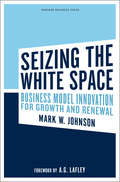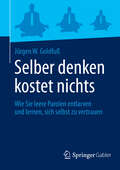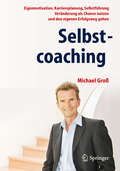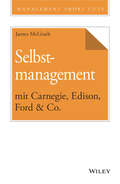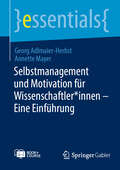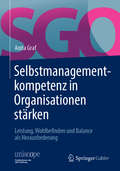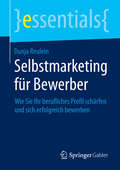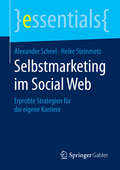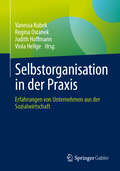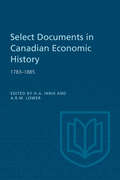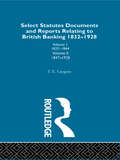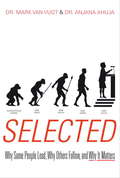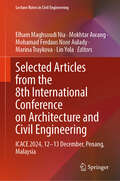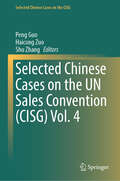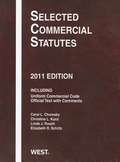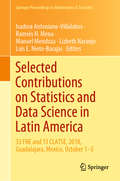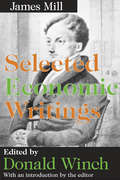- Table View
- List View
Seizing the White Space
by A. G. Lafley Mark W. JohnsonBusiness model innovation is the key to unlocking transformational growth-but few executives know how to apply it to their businesses. In Seizing the White Space, Mark Johnson gives them the playbook.Leaving the rhetoric to others, Johnson lays out an eminently practical framework that identifies the four fundamental building blocks that make business models work. In a series of in-depth case studies, he goes on to vividly illustrate how companies are using innovative business models to seize their white space and achieve transformational growth by fulfilling unmet customer needs in their current markets; serving entirely new customers and creating new markets; and responding to tectonic shifts in market demand, government policy, and technologies that affect entire industries. He then lays out a structured process for designing a new model and developing it into a profitable and thriving enterprise, while investigating the vexing and sometimes paradoxical managerial challenges that have commonly thwarted so many companies in their unguided forays into the unknown.Business model innovators have reshaped entire sectors-including retail, aviation, and media-and redistributed billions of dollars of value. With road-tested frameworks, analytics, and diagnostics, this book gives executives everything they need to reshape their businesses and achieve transformative growth.
Selassie Atadika: Entrepreneurship in Africa
by Boris Groysberg Susan Seligson Katherine Connolly BadenThis case profiles the career of Ghana-based chef and entrepreneur, Selassie Atadika. In the midst of the COVID-19 pandemic, she faced many questions about the future, such as: How could she convince Ghanaian consumers to view their native cuisine in a fresh, compelling way? How could she sustain the fine dining arm of Midunu, Atadika's food and lifestyle company, in a nation where the average annual income hovered at USD5,000? Should she expand her chocolate business internationally? As Atadika became an important player on the culinary world stage, what were the best ways to promote her business and capitalize on her increasingly high international profile?
Selber denken kostet nichts: Wie Sie leere Parolen entlarven und lernen, sich selbst zu vertrauen
by Jürgen W. GoldfußTschakka! Ein oft gehörter Ausruf, wenn es um Motivation, Machbarkeit und Erfolg geht. Aber so einfach ist es nicht. Manch plakative Weisheiten gewisser Erfolgsgurus und Motivationstrainer entpuppen sich als heiße Luft. Banale Tipps für Wege aus der Jobkrise oder dem Leistungstief werden geschickt vermarktet und teuer verkauft. Auf das professionell inszenierte Motivations- und Stimmungshoch solcher Events folgt jedoch nicht selten die Ernüchterung. Oft scheitern die verheißungsvollen Erfolgstipps an den Grenzen des Berufsalltags. Schlimmstenfalls verfestigen sich Empfindungen wie Frustration oder Hilflosigkeit noch stärker als zuvor. Doch es geht auch anders. Der Autor Jürgen W. Goldfuß räumt auf mit leeren Erfolgsversprechen und wohlklingenden Worthülsen. Sein Credo: Jeder Mensch verfügt in sich selbst über ausreichend Know-how, um ein Leben ohne Stress und Burnout zu führen. Jeder hat ein ganz eigenes Repertoir an Werkzeugen, um sich immer wieder neu zu motivieren, selbst zu vertrauen und zufrieden zu leben. Der erfahrene Publizist, Berater und Hobby-Kabarettist unterstützt Sie mit nachvollziehbaren, leicht umsetzbaren Tipps. Unterhaltsam beleuchtet er alltägliche sowie außergewöhnliche Situationen und zeigt, wie Sie daraus Gewinn ziehen und Ihre eigene Persönlichkeit stärken können.
Selbstcoaching: Eigenmotivation, Karriereplanung, Selbstführung - Veränderung als Chance nutzen und den eigenen Erfolgsweg gehen
by Michael GroßDas Berufsleben stellt uns immer wieder vor schwierige Entscheidungen, gewollte oder ungewollte Veränderungen, Konflikte, Phasen der Über- oder Unterforderung u.v.m. Wer heute erfolgreich sein will, sollte über Fähigkeiten verfügen, die uns helfen, diese Herausforderungen zu meistern: Selbstführungstechniken, Flexibilität, Veränderungsmotivation, Mut, ein "Gefühl für die Situation". Glücklicherweise sind diese Skills in jedem von uns angelegt! Dieses Buch will Ihnen helfen, sie herauszulocken und zu optimieren. Sie können es komplett lesen, oder Sie greifen danach, wann immer Sie vor einem konkreten Problem stehen: Teil 1 gibt Impulse, Ihre Motive, Stärken, Schwächen, Erwartungen zu analysieren und Ihre Ziele zu schärfen. Die Kapitel in Teil 2 gehen jeweils von typischen Situationen einer Berufskarriere aus, von der Berufswahl über Konfliktsituationen bis hin zu Gesundheitsproblemen, und helfen Ihnen, Schritt für Schritt Ihre ganz persönliche Herausforderung zu meistern. Teil 3 enthält einen Selbsttest: Wie steht es um meine Selbstführungs-Skills? Geschrieben von einem, der es wissen muss: Michael Groß ist nicht zuletzt durch seine Fähigkeit zur Selbstführung zum mehrfachen Schwimmolympiasieger und -weltmeister geworden und hat danach den Wandel vom Sportler zum promovierten Kommunikationswissenschaftler vollzogen. Durch seine heutige Tätigkeit als erfolgreicher Berater hat er die Praxiserfahrung, anderen seine "Skills" weiterzugeben. Lassen Sie sich durch seine Tipps und viele Beispiele aus der Biografie des Autors motivieren, die nächste Herausforderung in Angriff zu nehmen!
Selbstmanagement im Ruhestand: Coachingmodelle für mehr Resilienz und Gelassenheit im Alter
by Wolfgang SchieleDieses Buch übernimmt eine Doppelfunktion: Es stellt in leicht verständlicher Form erfolgreiche Coachingmodelle vor und fungiert zugleich als anwendungsorientierter Ratgeber für ein harmonisches und ausgeglichenes Leben im Übergang vom Beruf in den Ruhestand. Die in verdichteter Form vorgestellten Formate und Interventionen stehen in einem festen Bezug zum alternden Menschen. Sie geben dem Leser Werkzeuge an die Hand, um die Herausforderungen des fortgeschrittenen Erwachsenenalters im Selbstmanagement zu meistern und die psychische Widerstandskraft im Alter zu stärken. Die reiche Ausstattung des Werkes mit Grafiken, Arbeitsblättern und Testangeboten erleichtert dem Leser den Zugang zu den Modellen und macht Lust auf das Ausprobieren der vorgeschlagenen Übungen im Selbstversuch.
Selbstmanagement mit Carnegie, Edison, Ford & Co.
by James McGrathDas Buch "Selbstmanagement mit Carnegie, Edison, Ford & Co." aus der Reihe "Management Short Cuts" versammelt 11 Zitate von Business-Gurus und bekannten Persönlichkeiten. Bei jedem Zitat wird erklärt, was es bedeutet, wie Sie es nutzen können und welche Fragen Sie sich stellen sollten. Kurz, kompakt und auf den Punkt können Sie so schnell die Kernbotschaft erfassen und anwenden. Sie erhalten wertvolle Einblicke und Kenntnisse für Ihren Erfolg!
Selbstmanagement und Motivation für Wissenschaftler*innen – Eine Einführung (essentials)
by Georg Adlmaier-Herbst Annette MayerDieses essential ist ein kompakter Leitfaden zum Selbstmanagement für Wissenschaftler*innen: Welche praxiserprobten Modelle und Instrumente gibt es, um sich kontinuierlich weiterzuentwickeln? Selbstmanagement und Motivation sind für die wissenschaftliche Arbeit von zentraler Bedeutung: Ziele setzen und Energie freisetzen, um diese zu erreichen. Doch viele Wissenschaftler*innen stellt dies vor schwierige Herausforderungen: Unsicherheit durch befristete Arbeitsverträge, hohe Arbeitsbelastung und Erfolgsdruck. Viele zusätzliche Aufgaben in Lehre, Verwaltung und Selbstorganisation ziehen Zeit und Energie für die Forschung ab. Dieses Buch hilft, Ihre Ziele so zu entwickeln, dass diese im Einklang mit Ihrer Gesamtpersönlichkeit stehen und sich besser verwirklichen lassen. Den kostenlosen Zugang zum Online-Kurs finden Sie direkt im Buch.
Selbstmanagement und Motivation für Wissenschaftler*innen: Methoden, Modelle, Tools
by Annette Mayer D. Georg Adlmaier-HerbstIn diesem Buch lernen Sie wissenschaftlich fundierte Modelle kennen, mit denen Sie Ihr Selbstmanagement als Wissenschaftler*in systematisch und langfristig gestalten können. Im Zentrum des wissenschaftlichen Arbeitens steht der Inhalt. Jedoch ist auch gutes Selbstmanagement hilfreich, um zum optimalen Ergebnis zu gelangen. Selbstmanagement meint zum einen, sich für unliebsame oder herausfordernde Aufgaben zu motivieren, wie das langwierige Recherchieren in Bibliotheken, das Verfassen von Papers, das Fertigstellen von Dissertationen etc. Zum anderen bezeichnet Selbstmanagement auch das Verringern von negativen Gefühlen, wie Lampenfieber vor Präsentationen des eigenen Forschungsvorhabens, Unsicherheit vor wichtigen Gesprächen oder Konflikte mit Kollegen und Vorgesetzten. Gerade in Zeiten der zunehmenden Digitalisierung und der Arbeit im Homeoffice wird die eigene Motivation umso bedeutender, da oft die persönliche Ansprache und die Motivation durch den Kontakt und den Austausch im Team vermisst werden. Die Kernfrage lautet, wie Selbstmanagement im Einklang mit der eigenen Persönlichkeit und der eigenen Situation gelingen kann. Die Autoren leiten Sie an, eigene Stärken und Möglichkeiten als Ressourcen zu erkennen, diese wertzuschätzen und systematisch zu nutzen. Hierdurch können Sie auf eine neue, ressourcenorientierte Art mit sich umgehen und sich selbst ein wenig besser kennenlernen. Sie stellen positive Auswirkungen auf sich und andere fest und erweitern Ihren Entscheidungsspielraum sowie Ihr Handlungsrepertoire, auch in schwierigen Situationen.
Selbstmanagementkompetenz in Organisationen stärken
by Anita GrafDieses fundierte und umfassende Fachbuch stellt ein gut nachvollziehbares Modell vor, das alle wesentlichen Aspekte der Selbstmanagementkompetenz integriert. Die Fähigkeit, das eigene Leben selbstverantwortlich zu gestalten, kann auf einer individuellen und einer organisationalen Ebene erweitert und gefördert werden. Der handlungsorientierte Ansatz richtet sich sowohl an Mitarbeitende als auch an Führungskräfte und sensibilisiert für die Bedeutung eines umfassenden und gezielten Selbstmanagements.Das dynamische Modell besteht aus den drei Betrachtungsebenen Selbstverantwortung, Selbsterkenntnis und Selbstentwicklung, in das die Autorin sechs weitere Bausteine integriert: Ziele, Zeit und Informationen, physische und psychische Gesundheit, soziale Beziehungen, Selbstkontrolle und Selbstregulation sowie weitere relevante Aspekte der Persönlichkeit. In Summe entsteht so ein in sich stimmiges und ganzheitliches Bild des komplexen Phänomens Selbstmanagement.Für die 2. Auflage wurde das Buch komplett überarbeitet und maßgeblich erweitert. Besonders hervorzuheben sind die 14 Praxisbeispiele. Sie zeigen anwendungsorientiert auf, wie Organisationen bei der Förderung von Selbstmanagementkompetenz konkret vorgehen können. Damit werden diese Praxisbeispiele zu äußerst wertvollen Umsetzungshilfen.Die Stiftung der Schweizerischen Gesellschaft für Organisation und Management SGO unterstützte die dieser Publikation zugrunde liegende Studie.
Selbstmarketing für Bewerber: Wie Sie Ihr berufliches Profil schärfen und sich erfolgreich bewerben (essentials)
by Dunja ReuleinDieses Essential zeigt Ihnen, wie Sie sich nach dem Studium selbst positionieren und vermarkten, wie Sie auf dieser Basis eine Bewerbung souverän angehen und damit den Grundstein für Ihre weitere Karriere legen. Stärken-Schwächen-Profile und ausführliche Checklisten helfen Ihnen dabei, Ihre Qualifikationen und persönlichen Vorstellungen mit den Anforderungen des Arbeitsmarktes abzugleichen und Fallstricke im Bewerbungsprozess zu vermeiden. Ergänzend vermittelt die Autorin zahlreiche Tipps und Tricks, die Ihnen die oft beschwerliche Bewerbungsphase erleichtern.
Selbstmarketing für Wissenschaftler*innen: Methoden, Modelle und Instrumente
by Annette Mayer D. Georg Adlmaier-HerbstDieses Buch unterstützt Sie als Wissenschaftler*in bei der authentischen und wirkungsvollen Darstellung Ihrer Leistungen und Ihrer Person. Sie erhalten wertvolle Anregungen, wie Sie sich bekannt machen, bei Ihren wichtigen Bezugsgruppen ein klares Bild Ihrer wissenschaftlichen Tätigkeit aufbauen, diese von deren Nutzen überzeugen und die eigene soziale Verantwortung aufzeigen können. Die Autor*innen führen Sie anhand von wissenschaftlich fundierten Modellen, praxiserprobten Tools und vielen Checklisten durch das eigene Selbstmarketing:- Sie bestimmen Ihre Ziele als Wissenschaftler*in,- Sie entwickeln Ihre individuelle Positionierung im wissenschaftlichen Umfeld, - Sie definieren Bezugsgruppen und kommunizieren wirkungsvoll. Auch auf den kritischen Dialog können Sie sich anhand von zahlreichen Techniken und Instrumenten vorbereiten. Sorgen Sie dafür, dass Ihre wichtigen Bezugsgruppen Sie mit relevanten Eigenschaften verbinden, die Sie einzigartig und attraktiv machen.Der Inhalt• Einführung in das Selbstmarketing• Selbstverständnis über die eigene Person• Erlebnisversprechen der Wissenschaftler*innen• Die Positionierung• Bezugsgruppen• Ziele des Selbstmarketing• Vermitteln der Persönlichkeit• Social Media im Selbstmarketing• Wirkungsvolle Techniken im Selbstmarketing• Störungen und Konflikte• Das Konzept für Ihr Selbstmarketing
Selbstmarketing im Social Web: Erprobte Strategien für die eigene Karriere (essentials)
by Alexander Scheel Heike SteinmetzDieses Essential zeigt Ihnen, welche Social-Media-Netzwerke für die Stellensuche relevant sind, welche ungeschriebenen Gesetze Bewerber befolgen sollten und nach welchen Kriterien Personalverantwortliche und -berater potenzielle Mitarbeiter aussuchen. Alexander Scheel und Heike Steinmetz schildern, wie Sie sich erfolgreich im Social Web positionieren, Massenmails von Headhuntern zuverlässig von ehrlich gemeinten Angeboten unterscheiden und Ihrerseits an Informationen über den Arbeitgeber kommen. Die Ratschläge basieren auf der jahrelangen praktischen Erfahrung der Autoren, die Unternehmen beim Aufbau der Arbeitgebermarke, beim Personalmarketing sowie bei der Suche nach Mitarbeitern unterstützen.
Selbstorganisation in der Praxis: Erfahrungen von Unternehmen aus der Sozialwirtschaft
by Vanessa Kubek Regina Osranek Viola Hellge Judith HoffmannDieser Sammelband beschreibt die Grundlagen selbstorganisierten Arbeitens, v.a. Werte, Haltungen, Organisationsmodelle, Führungsansätze und Zusammenarbeitstechniken. Er zeigt konkrete Umsetzungswege auf, die von Einrichtungen der Sozialwirtschaft beschritten wurden. Dabei wird ein vielfältiges Spektrum gezeichnet: Von der Gestaltung eines energiestiftenden Auftakts des Organisationsentwicklungsprozesses, über konkrete Veränderungen in den Bereichen Kundenorientierung, Führung, Zusammenarbeit, arbeitsorganisatorische Maßnahmen hin zu wichtigen Detailthemen wie Wertschätzung und Feedback mündet der Band in einer kritischen Reflexion, wieviel Ausdauer der Weg in Richtung „mehr Selbstorganisation“ erfordert. Den Abschluss bildet ein Interview mit Führungskräften aus den Unternehmen der Sozialwirtschaft, die im Buch beispielhaft illustriert werden, und die von ihren persönlichen positiven wie auch herausfordernden Erfahrungen berichten. Die praktischen Beispiele zeigen, dass die Wege in Richtung Selbstorganisation vielfältig sind. Sie sollen Einrichtungen der Sozialwirtschaft anregen, ihre eigenen Wege zu gehen.
Selbstorganisiertes Lernen im Unternehmen
by Werner BünnagelDieses Buch will auf ein neues berufliches Lernen vorbereiten, denkt Fortschritte voraus und zeigt neue Wege in die Zukunft auf. Es ist ein Leitfaden für selbstorganisiertes Lernen. Mit praxiserprobten Tipps und mit ganz pragmatischen Handlungsempfehlungen.
Select Documents in Canadian Economic History 1783-1885
by Harold Innis Arthur LowerThis second volume of economic documents resumes the story of the development of Canada as told by contemporary sources. Newspaper accounts of economic forces and factors, contemporary writings by statesmen and business men, poems depicting current situations, official documents—all have been included. The volume divides the period into two eras, 1783-1850 and 1850-85. The basis of classification of entries is by topics and geographic sections. It is hoped that the material which follows will amplify and illustrate the blend of materialistic and non-materialistic factors which has determined the nature of Canadian history and will allow students in Canadian universities to study with some degree of fullness the development of the economic institutions of their native land.
Select Statutes, Documents and Reports Relating to British Banking, 1832-1928
by T. E. GregoryFirst Published in 1964. This is Volume I of two that forms a collection of select statues documents and reports around the banking industry within Britain from 1832 to 1928. This volume includes up to 1844, looking at the state of banking before The Act of 1844 and also the Bank Charter Act.
Select: Jumpstart the Cycle of Excellence-Encourage Peak Performance by Putting the Right Person in the Right Job
by Edward M. Hallowell John A. Quelch Heather BeckhamAs General Electric CEO Jack Welch said, "Getting the right people in the right jobs is a lot more important than developing a strategy." Smart managers know that job fit means paying attention to three things: what a person likes to do most; what he or she does best; and what adds the greatest value to the project or organization. In this chapter, bestselling author ("Driven to Distraction") and practicing psychiatrist Edward Hallowell focuses on "Select," the first of five steps in the Cycle of Excellence. He uses real-life examples to demonstrate the importance of fit-that when there's a mismatch between the employee and the job, everything that follows, no matter how fervent the effort, suffers. He also explains how to recognize a bad fit and what to do to fix it. The chapter offers practical steps you can take today-including the "Hallowell Self-Report Job-Fit" questionnaire-that will help you identify your employees' strengths and interests and match them to the particular challenges of your organization. The chapter concludes with a discussion of "conative style"-defined as an individual's natural, inborn style of solving a problem-and how understanding this characteristic in each of your employees can help you put the right person in the right job. This chapter was originally published as Chapter 2 of "Shine: Using Brain Science to Get the Best from Your People."
Selected
by Mark Van Vugt Anjana AhujaA groundbreaking, evolutionary science-based exploration of the history of leadership that explains how and why some men and women evolve into good or great leaders, and some do not.We are all leaders or followers -- or both. We can recognise leadership in almost every area of life: in the workplace, among friends, within families, in politics and religion. But what makes a good or bad leader, and what makes an outstanding one? Selected examines how and why leadership has evolved over tens of thousands of years, and presents a bold and compelling new "mismatch hypothesis": the slowness of evolution means that there is a mismatch between modern leadership and the kind of leadership that our Stone Age brains are still wired for. This makes for all sorts of tendencies, problems and solutions that no author has yet discussed but that affect all aspects of our lives.Full of fascinating examples drawn from a diverse range of spheres, from politics and commerce to sport and culture, Selected explains why taller political candidates usually win, why women chief executives attract such hostility, why we like it when the boss asks after our children and what prime ministers and presidents can do to improve their chances of electoral success.This is the first book of its kind -- reaching into business, psychology, politics and current affairs -- to explore how leadership affects us all. It also offers the first truly scientific theory of leadership: where previous books have provided anecdote, it details empirical evidence. Selected provides deep insight into our personal and professional lives at a time when the world urgently needs to acknowledge great leadership.From the Hardcover edition.
Selected Articles from the 8th International Conference on Architecture and Civil Engineering: ICACE 2024, 12-13 December, Penang, Malaysia (Lecture Notes in Civil Engineering #635)
by Mokhtar Awang Lin Yola Elham Maghsoudi Nia Mohamad Ferdaus Noor Aulady Marina TraykovaThis book highlights the latest research developments in civil engineering and architectural materials, reflecting the innovative works presented at the 8th International Conference on Architecture and Civil Engineering, and Technology (ICACE 2024) held on 12-13 December at Parkroyal Hotel Penang, Malaysia. It provides an opportunity to explore cutting-edge findings and advancements that are shaping the future of these fields. By bringing together experts and scholars from around the world, ICACE 2024 aims to promote collaboration and knowledge sharing, contributing to the ongoing evolution of architecture and civil engineering.
Selected Chinese Cases on the UN Sales Convention (Selected Chinese Cases on the CISG)
by Peng Guo Haicong Zuo Shu ZhangThis book focuses on Chinese cases on the CISG decided by Chinese courts of all levels, focusing on those decided from 2013 to 2016. During this period, the number of cases grew fast compared to 2010 to 2012 covered in volume 3. The growth in the total number reflects that parties might become more familiar with the CISG and therefore decided not to opt out of it; in addition, the case collection and report systems in China at that time were developing very fast, rendering many cases easily accessible. This book provides a comprehensive and detailed analysis of selected cases. The analysis of those cases will be on a case-by-case basis. For each case, an English summary of the judgment will be provided. In the comment, the People’s Courts’ approach to the interpretation and application of the CISG will be discussed. Comments of the individual case will be written either by scholars, or judges or lawyers from international and comparative perspectives to discuss the successes and pitfalls of the interpretation and application of the CISG in China. These selected cases reflect how People’s Court of all levels started to deal with various issues arising from the CISG and will help understand whether and how the People’s Courts change their approaches to the interpretation and application of the CISG in the future.
Selected Commercial Statutes 2011
by Carol L. Chomsky Christina L. KunzThis product provides a collection of uniform laws and federal statutes for use in all commercial law courses. It begins with the most widely used version of the Uniform Commercial Code, consisting of the 2009 version of Articles 1 and 3-9 and the 2002 version of Articles 2 and 2A. Appendixes contain the Permanent Editorial Board commentaries, as well as earlier versions of Articles 1, 3, 4, and 7, and the 2003 and 2005 amendments to Articles 2 and 2A, in underline-strikeout form with the Official Comments. It also includes additional uniform laws and significant federal commercial legislation and regulations.
Selected Contributions on Statistics and Data Science in Latin America: 33 FNE and 13 CLATSE, 2018, Guadalajara, Mexico, October 1−5 (Springer Proceedings in Mathematics & Statistics #301)
by Ramsés H. Mena Isadora Antoniano-Villalobos Manuel Mendoza Lizbeth Naranjo Luis E. Nieto-BarajasThe volume includes a collection of peer-reviewed contributions from among those presented at the main conference organized yearly by the Mexican Statistical Association (AME) and every two years by a Latin-American Confederation of Statistical Societies. For the 2018 edition, particular attention was placed on the analysis of highly complex or large data sets, which have come to be known as “big data”. Statistical research in Latin America is prolific and research networks span within and outside the region. The goal of this volume is to provide access to selected works from Latin-American collaborators and their research networks to a wider audience. New methodological advances, motivated in part by the challenges of a data-driven world and the Latin American context, will be of interest to academics and practitioners around the world.
Selected Decisions and Selected Documents of the International
by International Monetary FundA report from the International Monetary Fund.
Selected Decisions and Selected Documents of the International Monetary Fund
by International Monetary FundA report from the International Monetary Fund.
Selected Economic Writings
by James MillJames Mill was the consummate utilitarian economist and theorist: his numerous intellectual interests and practical pursuits shatter the net boundaries of modern specialist scholarship in social science.Mill's many-sided genius was primarily a product of the age in which he lived. The late eighteenth and early nineteenth centuries saw a remarkable flowering of intellectual genius in Scotland in all of the arts and sciences, which gave the country a leading place in the broad European movement known as the Enlightenment, Mill being in fact only one of many brilliant men Scotland produced at that time.Mill's writings in this volume, first published in 1966, cover his development as an economist and are an attempt to assess his contribution to classic political economy. Particular attention is paid to the formative but less well-known pre-Benthamite period of his life. The volume opens with a substantial biographical assessment of Mill's life and work. The selections are specifically divided into four groups consisting of: early economic writings (""An Essay of the Impolicy of a Bounty on the Exportation of Grain,"" ""Commerce Defended,"" and ""Smith on Money and Exchange""); James Mill and David Ricardo (""Elements of Political Economy""); Mill on scope and method (""Whether Political Economy is Useful""); and Mill and India (""History of British India""). Donald Winch provides an introduction to each section that contextualizes the essays in Mill's own work and the economic thought of the time.James Mill: Selected Economic Writings is sure to be of interest to students of economic theory and social policy. One of the founders of utilitarianism, he adopted that doctrine to both British conditions and Britain's broader imperial pursuits.Donald Winch is professor of economics at the University of Sussex. He has authored and edited many books and papers on economics, economic theory, economic policy and economic history.
